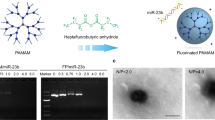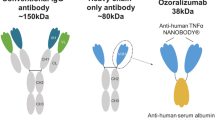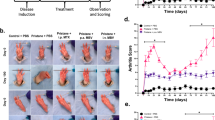Key Points
-
Systemic drug administration often results in off-site, on-target activity as well as amplification of off-target effects, with increased risk of adverse events
-
Active targeting to deliver therapeutic agents to disease-affected tissues is being developed as a modality to promote in situ drug activity and decrease systemic toxicity
-
Drug encapsulation within nanoparticles is a useful approach to provide protection from degradation and activation in the circulation and to reduce systemic activity
-
Antibodies are powerful targeting agents as both stand-alone therapeutics or as delivery methods to specifically direct drug conjugates to sites of active disease
-
The development of novel drugs with targeting and multi-specific properties will improve therapeutic indexes and could represent the next generation of RA therapeutics
Abstract
Despite major advances in the treatment of rheumatoid arthritis (RA) led by the success of biologic therapies, the lack of response to therapy in a proportion of patients, as well as therapy discontinuation owing to systemic toxicity, are still unsolved issues. Unchecked RA might develop into progressive structural joint damage, loss of function and long-term disability, disorders which are associated with a considerable health–economic burden. Therefore, new strategies are required to actively target and deliver therapeutic agents to disease sites in order to promote in situ activity and decrease systemic toxicity. Polymer–drug conjugates can improve the pharmacokinetics of therapeutic agents, conferring desirable properties such as increased solubility and tissue penetration at sites of active disease. Additionally, nanotechnology is an exciting modality in which drugs are encapsulated to protect them from degradation or early activation in the circulation, as well as to reduce systemic toxicity. Together with the targeting capacity of antibodies and site-specific peptides, these approaches will facilitate selective accumulation of therapeutic agents in the inflamed synovium, potentially improving drug efficacy at disease sites without affecting healthy tissues. This Review aims to summarize key developments in the past 5 years in polymer conjugation, nanoparticulate drug delivery and antibody or peptide-based targeting—strategies that might constitute the platform for the next generation of RA therapeutics.
This is a preview of subscription content, access via your institution
Access options
Subscribe to this journal
Receive 12 print issues and online access
$209.00 per year
only $17.42 per issue
Buy this article
- Purchase on Springer Link
- Instant access to full article PDF
Prices may be subject to local taxes which are calculated during checkout



Similar content being viewed by others
References
Canal, F., Sanchis, J. & Vicent, M. J. Polymer—drug conjugates as nano-sized medicines. Curr. Opin. Biotechnol. 22, 894–900 (2011).
Jatzkewitz, H. Peptamin (glycyl-L-leucyl-mescaline) bound to blood plasma expander (polyvinylpyrrolidone) as a new depot form of a biologically active primary amine (mescaline). Z. Naturforsch. 10, 27–31 (1955).
Ringsdorf, H. Structure and properties of pharmacologically active polymers. J. Polym. Sci. Pol. Sym. 51, 135–153 (1975).
Wenjun, L., Peng, Z., Erik De, C., Hongxiang, L. & Xinyong, L. Current drug research on PEGylation with small molecular agents. Prog. Polym. Sci. 38, 412–444 (2013).
Zhang, L. & Granick, S. How to stabilize phospholipid liposomes (using nanoparticles). Nano Lett. 6, 694–698 (2006).
Torchilin, V. P. Recent advances with liposomes as pharmaceutical carriers. Nat. Rev. Drug Discov. 4, 145–160 (2005).
McInnes, I. & O'Dell, J. State-of-the-art: rheumatoid arthritis. Ann. Rheum. Dis. 69, 1898–1906 (2010).
Naor, D. & Nedvetzki, S. CD44 in rheumatoid arthritis. Arthritis Res. Ther. 5, 105–115 (2003).
van der Heijden, J. W. et al. Folate receptor β as a potential delivery route for novel folate antagonists to macrophages in the synovial tissue of rheumatoid arthritis patients. Arthritis Rheum. 60, 12–21 (2009).
Wilder, R. L. Integrin αVβ3 as a target for treatment of rheumatoid arthritis and related rheumatic diseases. Ann. Rheum. Dis. 61 (Suppl. 2), ii96–ii99 (2002).
Abuchowski, A., van Es, T., Palczuk, N. C. & Davis, F. F. Alteration of immunological properties of bovine serum albumin by covalent attachment of polyethylene glycol. J. Biol. Chem. 252, 3578–3581 (1977).
Pasut, G. & Veronese, F. M. State of the art in PEGylation: the great versatility achieved after forty years of research. J. Control. Release 161, 461–472 (2012).
Maeda, H., Nakamura, H. & Fang, J. The EPR effect for macromolecular drug delivery to solid tumors: Improvement of tumor uptake, lowering of systemic toxicity, and distinct tumor imaging in vivo. Adv. Drug Deliv. Rev. 65, 71–79 (2013).
Paleolog, E. The vasculature in rheumatoid arthritis: cause or consequence? Int. J. Exp. Pathol. 90, 249–261 (2009).
Konisti, S., Kiriakidis, S. & Paleolog, E. Hypoxia—a key regulator of angiogenesis and inflammation in rheumatoid arthritis. Nat. Rev. Rheumatol. 8, 153–162 (2012).
Sundy, J. S. et al. Pharmacokinetics and pharmacodynamics of intravenous PEGylated recombinant mammalian urate oxidase in patients with refractory gout. Arthritis Rheum. 56, 1021–1028 (2007).
Sundy, J. S. et al. Reduction of plasma urate levels following treatment with multiple doses of pegloticase (polyethylene glycol-conjugated uricase) in patients with treatment-failure gout: results of a phase II randomized study. Arthritis Rheum. 58, 2882–2891 (2008).
Sundy, J. S. et al. Efficacy and tolerability of pegloticase for the treatment of chronic gout in patients refractory to conventional treatment: two randomized controlled trials. JAMA 306, 711–720 (2011).
Niti, G. & Sue, S. Certolizumab pegol. MAbs 2, 137–147 (2010).
Palframan, R., Airey, M., Moore, A., Vugler, A. & Nesbitt, A. Use of biofluorescence imaging to compare the distribution of certolizumab pegol, adalimumab, and infliximab in the inflamed paws of mice with collagen-induced arthritis. J. Immunol. Methods 348, 36–41 (2009).
Kong, J. S. et al. Suppression of neovascularization and experimental arthritis by D-form of anti-flt-1 peptide conjugated with mini-PEG™. Angiogenesis 14, 431–442 (2011).
Quan, L. D. et al. Pharmacokinetic and biodistribution studies of N-(2-hydroxypropyl)methacrylamide copolymer-dexamethasone conjugates in adjuvant-induced arthritis rat model. Mol. Pharm. 7, 1041–1049 (2010).
Quan, L. D. et al. Development of a macromolecular prodrug for the treatment of inflammatory arthritis: mechanisms involved in arthrotropism and sustained therapeutic efficacy. Arthritis Res. Ther. 12, R170 (2010).
Quan, L. et al. Nanomedicines for inflammatory arthritis: head-to-head comparison of glucocorticoid-containing polymers, micelles, and liposomes. ACS Nano 8, 458–466 (2014).
Grace, M. et al. Structural and biologic characterization of pegylated recombinant IFN-α2b. J. Interferon Cytokine Res. 21, 1103–1115 (2001).
Liu, X. M. et al. Syntheses of click PEG-dexamethasone conjugates for the treatment of rheumatoid arthritis. Biomacromolecules 11, 2621–2628 (2010).
Shin, J. M. et al. A hyaluronic acid-methotrexate conjugate for targeted therapy of rheumatoid arthritis. Chem. Commun. (Camb.) 50, 7632–7635 (2014).
Kim, Y. J. et al. Ionic complex systems based on hyaluronic acid and PEGylated TNF-related apoptosis-inducing ligand for treatment of rheumatoid arthritis. Biomaterials 31, 9057–9064 (2010).
Gregoriadis, G. Drug entrapment in liposomes. FEBS Lett. 36, 292–296 (1973).
Petros, R. A. & DeSimone, J. M. Strategies in the design of nanoparticles for therapeutic applications. Nat. Rev. Drug Discov. 9, 615–627 (2010).
Jung, Y. S., Park, W. & Na, K. Temperature-modulated noncovalent interaction controllable complex for the long-term delivery of etanercept to treat rheumatoid arthritis. J. Control. Release 171, 143–151 (2013).
Lee, S. M. et al. Targeted chemo-photothermal treatments of rheumatoid arthritis using gold half-shell multifunctional nanoparticles. ACS Nano 7, 50–57 (2013).
Mitragotri, S. & Yoo, J. W. Designing micro- and nano-particles for treating rheumatoid arthritis. Arch. Pharm. Res. 34, 1887–1897 (2011).
Choi, H. S. et al. Renal clearance of quantum dots. Nat. Biotechnol. 25, 1165–1170 (2007).
Moghimi, S. M., Hunter, A. C. & Murray, J. C. Long-circulating and target-specific nanoparticles: theory to practice. Pharmacol. Rev. 53, 283–318 (2001).
Vanniasinghe, A. S., Bender, V. & Manolios, N. The potential of liposomal drug delivery for the treatment of inflammatory arthritis. Semin. Arthritis Rheum. 39, 182–196 (2009).
Thomas, T. et al. Folate-targeted nanoparticles show efficacy in the treatment of inflammatory arthritis. Arthritis Rheum. 63, 2671–2680 (2011).
Zhang, T., Bai, X. & Mao, X. Systemic delivery of small interfering RNA targeting the interleukin-2/15 receptor β chain prevents disease progression in experimental arthritis. PLoS ONE 8, e78619 (2013).
Lee, S. J. et al. TNF-α gene silencing using polymerized siRNA/thiolated glycol chitosan nanoparticles for rheumatoid arthritis. Mol. Ther. 22, 397–408 (2014).
Bartlett, R. L. 2nd, Sharma, S. & Panitch, A. Cell-penetrating peptides released from thermosensitive nanoparticles suppress pro-inflammatory cytokine response by specifically targeting inflamed cartilage explants. Nanomedicine 9, 419–427 (2013).
Mero, A. et al. A hyaluronic acid-salmon calcitonin conjugate for the local treatment of osteoarthritis: chondro-protective effect in a rabbit model of early OA. J. Control. Release 187, 30–38 (2014).
Ryan, S. M. et al. An intra-articular salmon calcitonin-based nanocomplex reduces experimental inflammatory arthritis. J. Control. Release 167, 120–129 (2013).
de la Fuente, M., Seijo, B. & Alonso, M. J. Novel hyaluronic acid-chitosan nanoparticles for ocular gene therapy. Invest. Ophthalmol. Vis. Sci. 49, 2016–2024 (2008).
Heo, R. et al. Hyaluronan nanoparticles bearing γ-secretase inhibitor: in vivo therapeutic effects on rheumatoid arthritis. J. Control. Release 192, 295–300 (2014).
Scheinman, R. I., Trivedi, R., Vermillion, S. & Kompella, U. B. Functionalized STAT1 siRNA nanoparticles regress rheumatoid arthritis in a mouse model. Nanomedicine (Lond.) 6, 1669–1682 (2011).
Hou, K. K., Pan, H., Ratner, L., Schlesinger, P. H. & Wickline, S. A. Mechanisms of nanoparticle-mediated siRNA transfection by melittin-derived peptides. ACS Nano 7, 8605–8615 (2013).
Zhou, H. F. et al. Peptide-siRNA nanocomplexes targeting NF-κB subunit p65 suppress nascent experimental arthritis. J. Clin. Invest. 124, 4363–4374 (2014).
Burmester, G. R., Feist, E. & Dorner, T. Emerging cell and cytokine targets in rheumatoid arthritis. Nat. Rev. Rheumatol. 10, 77–88 (2014).
Brouwers, A. H. et al. Optimization of radioimmunotherapy of renal cell carcinoma: labeling of monoclonal antibody cG250 with 131I, 90Y, 177Lu, or 186Re. J. Nucl. Med. 45, 327–337 (2004).
Low, P. S., Henne, W. A. & Doorneweerd, D. D. Discovery and development of folic-acid-based receptor targeting for imaging and therapy of cancer and inflammatory diseases. Acc. Chem. Res. 41, 120–129 (2008).
Kiriakidis, S. & Paleolog, E. M. Vascular endothelium—role in chronic inflammatory disease. Postepy Biochem. 59, 415–423 (2013).
Raatz, Y., Ibrahim, S., Feldmann, M. & Paleolog, E. M. Gene expression profiling and functional analysis of angiogenic markers in murine collagen-induced arthritis. Arthritis Res. Ther. 14, R169 (2012).
Bono, M. R. et al. The essential role of chemokines in the selective regulation of lymphocyte homing. Cytokine Growth Factor Rev. 18, 33–43 (2007).
Garrood, T., Lee, L. & Pitzalis, C. Molecular mechanisms of cell recruitment to inflammatory sites: general and tissue-specific pathways. Rheumatology (Oxford) 45, 250–260 (2006).
Blades, M. et al. Stromal cell-derived factor 1 (CXCL12) induces monocyte migration into human synovium transplanted onto SCID mice. Arthritis Rheum. 46, 824–836 (2002).
Wahid, S. et al. Tumour necrosis factor-α (TNF-α) enhances lymphocyte migration into rheumatoid synovial tissue transplanted into severe combined immunodeficient (SCID) mice. Clin. Exp. Immunol. 122, 133–175 (2000).
Lee, L. et al. Identification of synovium-specific homing peptides by in vivo phage display selection. Arthritis Rheum. 46, 2109–2129 (2002).
Yang, Y. H., Rajaiah, R., Ruoslahti, E. & Moudgil, K. D. Peptides targeting inflamed synovial vasculature attenuate autoimmune arthritis. Proc. Natl Acad. Sci. USA 108, 12857–12862 (2011).
Kanakaraj, P. et al. Simultaneous targeting of TNF and Ang2 with a novel bispecific antibody enhances efficacy in an in vivo model of arthritis. MAbs 4, 600–613 (2012).
Kamperidis, P. et al. Development of a novel recombinant biotherapeutic with applications in targeted therapy of human arthritis. Arthritis Rheum. 63, 3758–3767 (2011).
Joosten, L. A. et al. Role of interleukin-4 and interleukin-10 in murine collagen-induced arthritis. Protective effect of interleukin-4 and interleukin-10 treatment on cartilage destruction. Arthritis Rheum. 40, 249–260 (1997).
Weinblatt, M. et al. rHUIL-10 (tenovil) plus methotrexate (MTX) in active rheumatoid arthritis (RA): a phase I and cytokine response study. Arthritis Rheum. 40 (Suppl.), 224 (1999).
Schwager, K. et al. Preclinical characterization of DEKAVIL (F8-IL10), a novel clinical-stage immunocytokine which inhibits the progression of collagen-induced arthritis. Arthritis Res. Ther. 11, R142 (2009).
Doll, F., Schwager, K., Hemmerle, T. & Neri, D. Murine analogues of etanercept and of F8-IL10 inhibit the progression of collagen-induced arthritis in the mouse. Arthritis Res. Ther. 15, R138 (2013).
Hughes, C. et al. Targeting of viral interleukin-10 with an antibody fragment specific to damaged arthritic cartilage improves its therapeutic potency. Arthritis Res. Ther. 16, R151 (2014).
Hemmerle, T., Doll, F. & Neri, D. Antibody-based delivery of IL4 to the neovasculature cures mice with arthritis. Proc. Natl Acad. Sci. USA 111, 12008–12012 (2014).
Wythe, S. E. et al. Targeted delivery of cytokine therapy to rheumatoid tissue by a synovial targeting peptide. Ann. Rheum. Dis. 72, 129–135 (2013).
Macor, P. et al. Treatment of experimental arthritis by targeting synovial endothelium with a neutralizing recombinant antibody to C5. Arthritis Rheum. 64, 2559–2567 (2012).
Rollett, A. et al. HSA nanocapsules functionalized with monoclonal antibodies for targeted drug delivery. Int. J. Pharm. 458, 1–8 (2013).
Mi, Z. et al. Identification of a synovial fibroblast-specific protein transduction domain for delivery of apoptotic agents to hyperplastic synovium. Mol. Ther. 8, 295–305 (2003).
Pierschbacher, M. D. & Ruoslahti, E. Cell attachment activity of fibronectin can be duplicated by small synthetic fragments of the molecule. Nature 309, 30–33 (1984).
Vanniasinghe, A. S. et al. Targeting fibroblast-like synovial cells at sites of inflammation with peptide targeted liposomes results in inhibition of experimental arthritis. Clin. Immunol. 151, 43–54 (2014).
Zhou, H. F. et al. Fumagillin prodrug nanotherapy suppresses macrophage inflammatory response via endothelial nitric oxide. ACS Nano 8, 7305–7317 (2014).
Lee, H. et al. Hyaluronate-gold nanoparticle/tocilizumab complex for the treatment of rheumatoid arthritis. ACS Nano 8, 4790–4798 (2014).
Chan, A. C. & Carter, P. J. Therapeutic antibodies for autoimmunity and inflammation. Nat. Rev. Immunol. 10, 301–316 (2010).
Nam, J. L. et al. Current evidence for the management of rheumatoid arthritis with biological disease-modifying antirheumatic drugs: a systematic literature review informing the EULAR recommendations for the management of RA. Ann. Rheum. Dis. 69, 976–986 (2010).
Genovese, M. C. et al. Combination therapy with etanercept and anakinra in the treatment of patients with rheumatoid arthritis who have been treated unsuccessfully with methotrexate. Arthritis Rheum. 50, 1412–1419 (2004).
Liu, M. et al. A novel bispecific antibody targeting tumor necrosis factor α and ED-B fibronectin effectively inhibits the progression of established collagen-induce arthritis. J. Biotechnol. 186, 1–12 (2014).
Schwager, K. et al. Preclinical characterization of DEKAVIL (F8-IL10), a novel clinical-stage immunocytokine which inhibits the progression of collagen-induced arthritis. Arthritis Res. Ther. 11, R142 (2009).
Ferrari, M., Onuoha, S., Kamalati, T., Sblattero, D. & Pitzalis, C. Development of a novel bispecific therapeutic for arthritic diseases. Arthritis Rheum. 65, S218–S218 (2013).
Taylor, P. & Feldmann, M. Anti-TNF biologic agents: still the therapy of choice for rheumatoid arthritis. Nat. Rev. Rheumatol. 5, 578–660 (2009).
Yazici, Y. & Regens, A. L. Promising new treatments for rheumatoid arthritis—the kinase inhibitors. Bull NYU Hosp. Jt Dis. 69, 233–237 (2011).
US National Institutes of Health. ClinicalTrials.gov [online], (2008).
Vilar, G., Tulla-Puche, J. & Albericio, F. Polymers and drug delivery systems. Curr. Drug Deliv. 9, 367–394 (2012).
Hoekstra, M. et al. Factors associated with toxicity, final dose, and efficacy of methotrexate in patients with rheumatoid arthritis. Ann. Rheum. Dis. 62, 423–426 (2003).
Croft, D. R. et al. Complex CD44 splicing combinations in synovial fibroblasts from arthritic joints. Eur. J. Immunol. 27, 1680–1684 (1997).
Pitzalis, C., Kelly, S. & Humby, F. New learnings on the pathophysiology of RA from synovial biopsies. Curr. Opin. Rheumatol. 25, 334–344 (2013).
Strebhardt, K. & Ullrich, A. Paul Ehrlich's magic bullet concept: 100 years of progress. Nat. Rev. Cancer 8, 473–480 (2008).
US National Institutes of Health. ClinicalTrials.gov [online], (2014).
Acknowledgements
The authors would like to acknowledge The Nuffield Foundation (Oliver Bird PhD Studentship to M.F.) and Arthritis Research UK (Project Grant 20062).
Author information
Authors and Affiliations
Contributions
M.F. and S.C.O. contributed equally to the research of data for the article; all authors contributed substantially to discussion of the content, wrote the article and reviewed and edited the manuscript before submission.
Corresponding author
Ethics declarations
Competing interests
C.P. is the inventor in a patent regarding single-chain variable fragment A7, and an inventor in a patent regarding the synovium-targeting peptide 3.1. The other authors declare no competing interests.
Rights and permissions
About this article
Cite this article
Ferrari, M., Onuoha, S. & Pitzalis, C. Trojan horses and guided missiles: targeted therapies in the war on arthritis. Nat Rev Rheumatol 11, 328–337 (2015). https://doi.org/10.1038/nrrheum.2015.17
Published:
Issue Date:
DOI: https://doi.org/10.1038/nrrheum.2015.17



